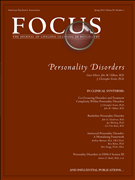Alternative DSM-5 Model for Personality Disorders
Abstract
The current approach to personality disorders appears in Section II of DSM-5, and an alternative model developed for DSM-5 is presented here in Section III. The inclusion of both models in DSM-5 reflects the decision of the APA Board of Trustees to preserve continuity with current clinical practice, while also introducing a new approach that aims to address numerous shortcomings of the current approach to personality disorders. For example, the typical patient meeting criteria for a specific personality disorder frequently also meets criteria for other personality disorders. Similarly, other specified or unspecified personality disorder is often the correct (but mostly uninformative) diagnosis, in the sense that patients do not tend to present with patterns of symptoms that correspond with one and only one personality disorder. In the following alternative DSM-5 model, personality disorders are characterized by impairments in personality functioning and pathological personality traits. The specific personality disorder diagnoses that may be derived from this model include antisocial, avoidant, borderline, narcissistic, obsessive-compulsive, and schizotypal personality disorders. This approach also includes a diagnosis of personality disorder—trait specified (PD-TS) that can be made when a personality disorder is considered present but the criteria for a specific disorder are not met.
(Reprinted from American Psychiatric Association: Diagnostic and Statistical Manual of Mental Disorders, 5th Ed. Washington, DC,APA, 2013. Copyright © 2013, American Psychiatric Association. Used with permission.)



